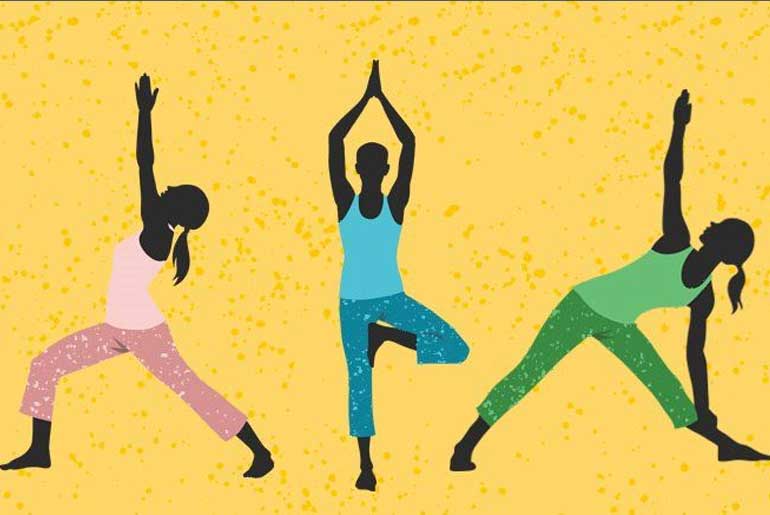Yoga offers a plethora of benefits, including toning and strengthening various parts of the body, particularly when targeting specific areas like the arms. By incorporating certain yoga asanas into a regular practice, individuals can effectively engage muscles in the arms, shoulders, and upper back, leading to improved strength, flexibility, and definition. These poses, when practiced mindfully and with proper alignment, can yield significant results in sculpting and toning the arms over time. It’s important to approach each pose with mindfulness, listening to the body and only pushing to a comfortable limit. With dedication and consistency, individuals can achieve stronger, more toned arms through the practice of yoga, while also reaping additional benefits for overall strength and flexibility.
1. Chaturanga Dandasana:
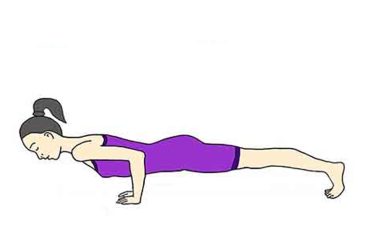
Chaturanga Dandasana, or Four-Limbed Staff Pose, is a challenging yoga asana that strengthens the arms, shoulders, and core muscles. To practice this pose, begin in plank pose, aligning your wrists directly under your shoulders and engaging your core. From plank, shift forward slightly while lowering your body down until your elbows form a 90-degree angle, keeping them close to your sides. Engage your core muscles to support your body and hold the pose for a few breaths. Chaturanga Dandasana builds upper body strength and stability, enhances core engagement, and prepares the body for more advanced yoga poses such as upward-facing dog or cobra pose. It’s important to maintain proper alignment and listen to your body to avoid strain or injury while practicing this pose.
2. Downward-Facing Dog:
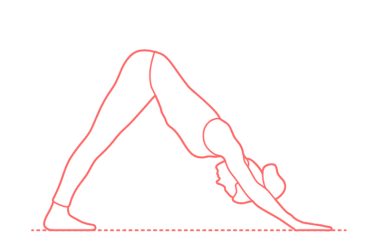
Downward-Facing Dog, or Adho Mukha Svanasana, is a fundamental yoga pose that offers a myriad of benefits, including stretching and strengthening the arms, shoulders, and upper back. To begin, come onto your hands and knees, aligning your wrists directly under your shoulders and your knees under your hips. From this tabletop position, tuck your toes and lift your hips upward toward the ceiling, forming an inverted V-shape with your body. Press firmly into your hands and fingers, distributing the weight evenly between your palms and fingers. Extend your arms fully while simultaneously lengthening your spine and engaging your core muscles. Allow your heels to sink toward the floor as you stretch through the backs of your legs. Hold the pose for several breaths, focusing on deep, steady breathing while actively engaging the muscles in your arms and shoulders to support the posture. Downward-Facing Dog is an excellent pose for improving flexibility, building strength, and releasing tension in the upper body, making it a staple in many yoga practices.
3. Plank Pose:
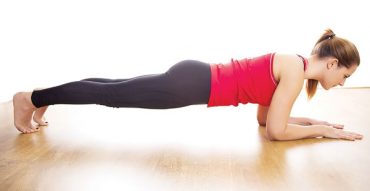
Plank Pose, or Santolanasana, is a foundational yoga pose that primarily targets the core muscles while also engaging the arms, shoulders, and legs. To practice Plank Pose, start in a push-up position with your hands placed directly beneath your shoulders and your arms straight. Ensure your body forms a straight line from your head to your heels, engaging your core muscles to maintain stability and support your spine. Keep your shoulders stacked directly above your wrists and avoid sinking or lifting your hips too high. Hold the pose for 30 seconds to 1 minute, focusing on maintaining strong and steady arms while keeping your breath steady and relaxed. Plank Pose is an excellent way to build core strength, improve posture, and enhance overall stability and endurance in the body.
4. Dolphin Pose:
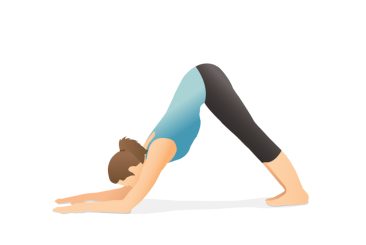
Dolphin Pose, or Ardha Pincha Mayurasana, is a yoga posture that primarily targets the shoulders, arms, and core muscles while also providing a gentle stretch for the hamstrings and calves. To practice Dolphin Pose, start on your hands and knees, ensuring your wrists are directly beneath your shoulders and your knees are below your hips. Lower down onto your forearms, placing your elbows directly beneath your shoulders and your forearms parallel to each other on the mat. With your palms pressing firmly into the ground, lift your hips upward and straighten your legs, forming an inverted V-shape with your body. Keep your head and neck relaxed, allowing your gaze to soften between your forearms or toward your feet. Engage your core muscles to support your spine and maintain stability in the pose, while also pressing firmly into your forearms to engage the muscles in your shoulders and arms. Hold Dolphin Pose for several breaths, focusing on maintaining steady and even breathing while feeling the stretch and strength building in your upper body.
5. Warrior II Pose:
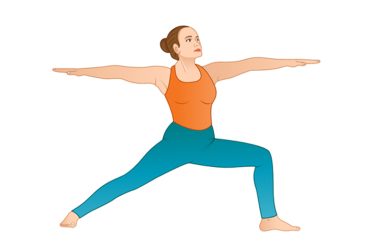
Warrior II Pose, or Virabhadrasana II, is a foundational yoga posture that cultivates strength, stability, and focus. To practice this pose, start in a lunge position with your front knee bent at a 90-degree angle and your back leg straight and strong. Extend your arms out to the sides at shoulder height, parallel to the floor, with your palms facing down. Keep your arms engaged and strong, feeling the energy extending through your fingertips. Gaze over your front fingertips, maintaining a steady and focused gaze as you feel the strength and power of the pose. Warrior II strengthens the legs, arms, and core muscles while also promoting balance and concentration, making it an essential posture in many yoga sequences.
6. Crow Pose:
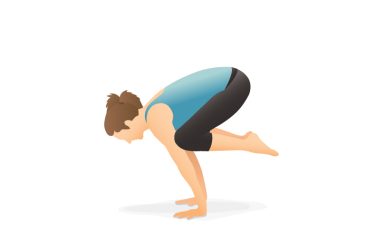
Crow Pose, also known as Bakasana, is an intermediate arm balance yoga pose that requires both strength and balance. To begin, start in a squat position with your feet hip-width apart and your palms flat on the mat in front of you. Shift your weight forward onto your hands, gently bending your elbows and bringing your knees to the back of your upper arms. Engage your core muscles as you lift your feet off the ground, finding balance on your hands. Keep your gaze slightly forward and press firmly through your palms to support your body weight, while also engaging your arm muscles to stabilize the pose. Crow Pose strengthens the arms, wrists, and core muscles, while also improving focus and concentration. Remember to breathe deeply and listen to your body, only progressing to the extent that feels comfortable and safe for you. With consistent practice, you can build strength and confidence in Crow Pose.
7. Extended Triangle Pose:
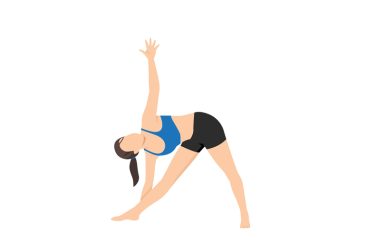
Extended Triangle Pose, or Utthita Trikonasana, is a foundational yoga posture that offers a deep stretch for the sides of the body while also engaging the arms and upper body. To practice this pose, begin in a wide-legged stance with your feet approximately 3 to 4 feet apart. Turn one foot out to the side, aligning the heel with the arch of the opposite foot, and extend your arms parallel to the floor. Reach actively toward the extended foot while keeping your torso elongated and your arms strong. Hold the pose for several breaths on each side, allowing yourself to deepen the stretch in the arms and upper body while maintaining steady and even breathing. Extended Triangle Pose promotes flexibility, strength, and balance while providing a thorough stretch for the arms and upper body.
8. Cow Face Pose:
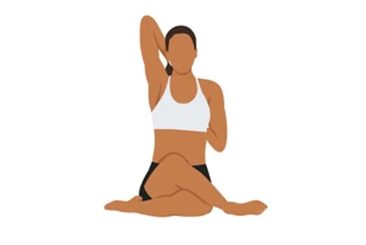
Cow Face Pose, also known as Gomukhasana Arms, is a yoga posture that stretches and opens the shoulders and arms. To practice this pose, begin by sitting tall with your legs crossed. Extend one arm overhead, palm facing down, and bend the elbow, bringing the hand down your back, palm facing outward. With your other hand, reach behind your back and clasp the fingers of both hands together. As you hold the pose, feel the stretch in your shoulders and arms, allowing the breath to deepen the stretch. After holding for a few breaths, release the arms and switch sides, repeating the same movements on the opposite side. Cow Face Pose is beneficial for improving shoulder flexibility and relieving tension in the upper body, making it a valuable addition to any yoga practice.
9. Upward Plank Pose:
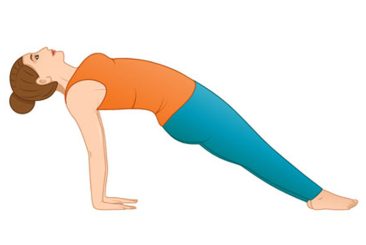
Upward Plank Pose, or Purvottanasana, is a dynamic yoga posture that strengthens the arms, shoulders, wrists, and core muscles while simultaneously stretching the front of the body. To begin, sit on the floor with your legs extended in front of you and your hands placed behind your hips, fingers pointing toward your feet. By pressing firmly into your hands and feet, lift your hips upward toward the ceiling, forming a straight line from your shoulders to your heels. Engage your arm and shoulder muscles to maintain stability in the pose while keeping your arms straight and strong. Hold the pose for several breaths, focusing on deepening the stretch in the shoulders and chest while keeping the core engaged. Upward Plank Pose is beneficial for improving posture, strengthening the upper body, and increasing overall body awareness.
10. Chair Pose:
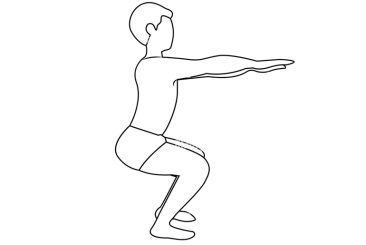
Chair Pose, or Utkatasana, is a foundational yoga posture primarily focused on strengthening the lower body, particularly the thighs, hips, and glutes. However, this pose also engages the arms and shoulders as they are extended overhead. The action of reaching the arms upward helps to tone and strengthen the muscles in the arms and shoulders, including the deltoids and triceps. While maintaining the lower body engagement and stability, practitioners benefit from the additional toning and sculpting of the upper body. Chair Pose offers a comprehensive full-body workout, promoting strength, flexibility, and balance when practiced regularly.
Incorporate these poses into your regular yoga practice to help tone your arms and enhance muscular definition. Remember to focus on proper alignment and engage your muscles mindfully for maximum benefit and safety.
Disclaimer:
The information contained in this article is for educational and informational purposes only and is not intended as a health advice. We would ask you to consult a qualified professional or medical expert to gain additional knowledge before you choose to consume any product or perform any exercise.

